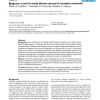SBP
2012
Springer
12 years 7 months ago
2012
Springer
The prevalence of cigarette smoking in the United States has declined very slowly over the last four decades, despite much effort by multiple governmental and non-governmental ins...
SBP
2012
Springer
12 years 7 months ago
2012
Springer
Developing the ability to comprehensively study infections in small populations enables us to improve epidemic models and better advise individuals about potential risks to their h...
INFOCOM
2011
IEEE
13 years 2 months ago
2011
IEEE
—Epidemic models based on nonlinear differential equations have been extensively applied in a variety of systems as diverse as infectious outbreaks, marketing, diffusion of belie...
SCFBM
2008
13 years 11 months ago
2008
Background: The construction of complex spatial simulation models such as those used in network epidemiology, is a daunting task due to the large amount of data involved in their ...
CSREASAM
2006
14 years 25 days ago
2006
- There are two types of models useful in the study of worm propagation for a given number of terminals in a trusted network i.e. deterministic and stochastic model. The determinis...
LADC
2007
Springer
14 years 5 months ago
2007
Springer
Given the frequent topology changes in Mobile Ad Hoc Networks (MANET), the choice of appropriate broadcasting techniques is crucial to ensure reliable delivery of messages. The spr...



